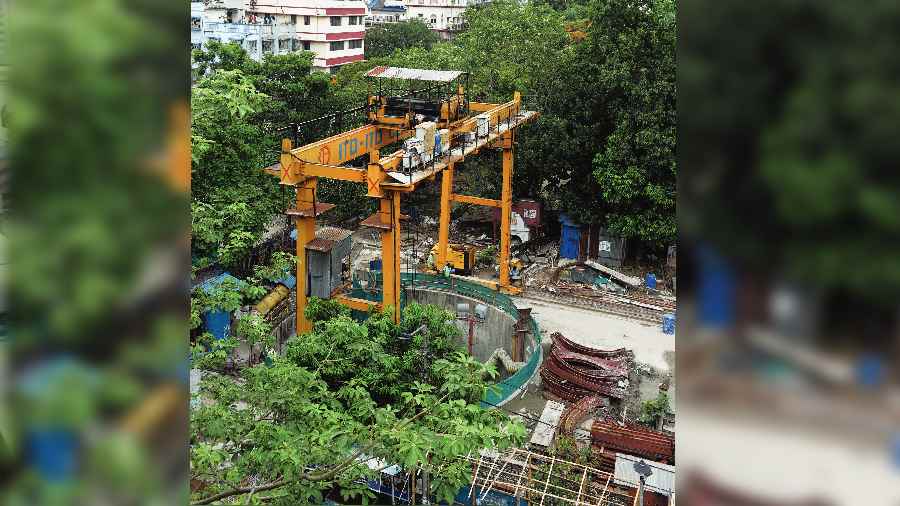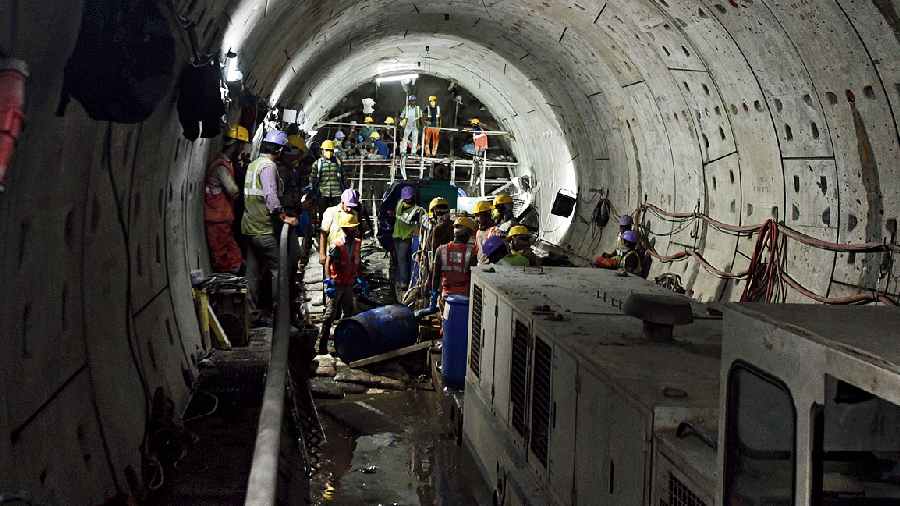The design of a ventilation shaft of the East-West Metro corridor at Subodh Mullick Square in central Kolkata was tweaked to prevent an accident like the one on May 11, said officials of the Kolkata Metro Rail Corporation (KMRC), the implementing agency of the project.
Three parallel structures connected to the shaft were part of the original plan, said an engineer.
A 58-metre arm of the shaft was supposed to be built from Subodh Mullick Square to Lenin Sarani for the ventilation of the Sealdah-bound tunnel.
A 25-metre arm was supposed to be built between Subodh Mullick Square and Nirmal Chunder Street for the Howrah-bound tunnel.
A third passage, 32 metres long, was to have been built, also between Subodh Mullick Square and Nirmal Chunder Street, for evacuation of passengers from both tunnels during an emergency.
In the tweak that was done in March, the KMRC decided not to build the 58-metre arm. Instead, they decided to extend the 25-metre arm by another 17 metres for the ventilation of the Sealdah-bound tunnel, said an official.
“The 25-metre tunnel would have provided ventilation to the Howrah Maidan-bound tunnel. The extended 42.2-metre tunnel will provide ventilation to the Sealdah-bound tunnel,” said a KMRC official.
“Like Bowbazar, the Lenin Sarani area, too, is very crowded. And there are a lot of old buildings. We wanted to avoid construction under the area keeping in mind the 2019 disaster. Also, Lenin Sarani is a very busy road and it would have been very difficult to stop traffic for construction.”
On August 31, 2019, a machine boring one of the tunnels under Bowbazar hit a sand aquifer, triggering subsidence that damaged over 80 homes and displaced hundreds of families.
On May 11, 2022, excavation of soil to grout a “blind spot” under the Howrah-bound tunnel led to leakage of water and soil subsidence, which in turn damaged nine buildings, according to the KMRC, and displaced 154 people. The civic body has put the number of damaged buildings at 13.
Construction of the shaft, meant to boost air circulation in tunnels between stations, began in March-end and traffic curbs were put in place. A 50-metre stretch of Nirmal Chunder Street has since remained closed for the construction.
The tweak also means that the passage meant for evacuation and originally planned to be 32m-long, will be shortened to 14m and will be used only for the ventilation of the Howrah-bound tunnel.
“It will not run till between the two tunnels as originally planned but connect the Howrah-bound tunnel with the shaft,” said the KMRC official.
A cross passage is being built between the two tunnels. “In case of an emergency in one tunnel, passengers can use the cross passage to reach the other tunnel,” the official said.
A KMRC official said intermediate ventilation shafts boost air circulation in tunnels between stations.
“When the distance between two stations is comparatively longer, an intermediate ventilation shaft is required to help the fans operate better at the two stations,” the official said.
Engineers said the shafts would suck out air in circulation and pump in fresh air. One such shaft has been built below Strand Road to boost air circulation in the tunnel between Mahakaran and Howrah stations on the East-West corridor.


